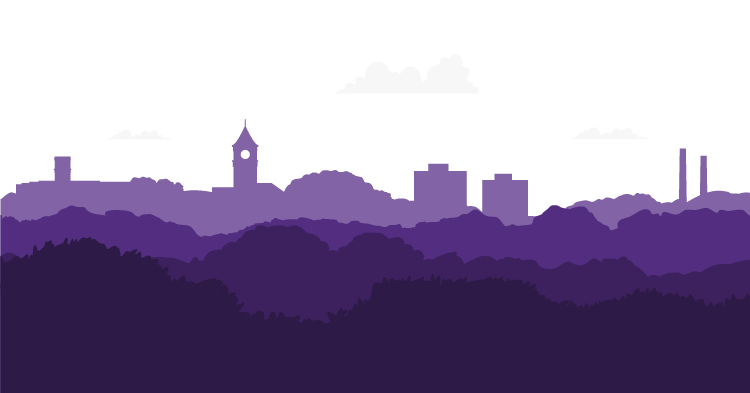Latin name: Shortia galacifolia
Common name: Oconee Bells
Flowers: Showy, white to pale pink bell-shaped flowers, bloom from March to April, slightly nodding, 1-3 inches, petals have fringed edges
Fruit or cones: Capsule, oval, July to August
Height & Width: 4 to 8 inches in height and 6 inches to 1 foot in width
Type: Herbaceous perennial
Habit: Low-growing ground cover
Wetland indicator category**: FACU
Texture: Medium
Growth rate: Slow to establish and slow spreading
Light: Part shade, but tolerant of heavy shade
Moisture: Medium
Soil*: Well-draining acidic soil
Zones: 5-7
Origin: Southeastern United States: South Carolina, North Carolina, Georgia, Tennessee, Virginia
Ecosystem benefits: Flowers attract pollinators and songbirds
Pests: Plants are relatively pest resistant if cultural preferences are met
Features: This plant is desirable because it has many ornamental features such as the white to pale pink, slightly nodding, bell-shaped flowers that bloom from March to April. The round glossy wavy margined leaves also provide winter interest because they turn a bronze to red color. In addition, this low-maintenance plant produces flowers that attract pollinators and songbirds.
Siting: This plant is native to wooded stream banks10,12 and is also often found in areas where there has been a disturbance such as a landslide or fallen tree12.
Care: Plant crown at soil level18. At planting, water the roots and surrounding area slowly and deeply. Keep soil moist until plant is established, then apply enough water to thoroughly moisten the root zone when the soil is dry or during drought. Modify water recommendations to reflect site drainage and rainfall. Apply 3” of mulch over the planted area. Do not allow mulch to touch the plant stems18.
Pests: Plants are relatively pest resistant if cultural preferences are met12,13.
This plant does not appear on the following invasive plant lists on (10/18/23): enter date searched and check or place an X showing the site(s) below that were examined
X USDA SC Invasive Plant Species
X SC Exotic Plant Pest Council
Sources:
- Armitage, A. (2001). Armitage’s manual of annuals, biennials, and half-hardy perennials. Portland, OR: Timber Press.
- Armitage, A. (2006). Armitage’s native plants for North American gardens. Portland, Oregon: Timber Press.
- Armitage, A. (2008). Herbaceous perennial plants: A treatise on their identification, culture, and garden attributes. Athens, GA: University of Georgia.
- Clemson Cooperative Extension Home and Garden Information Center.(2011). Flowers fact sheets. Retrieved from http://www.clemson.edu/extension/hgic/plants/landscape/flowers/
- Clemson Cooperative Extension Home and Garden Information Center.(2011). Groundcovers & vines fact sheets. Retrieved from http://www.clemson.edu/extension/hgic/plants/landscape/groundcovers/
- Clemson Cooperative Extension Home and Garden Information Center.(2011). Trees. Retrieved from http://www.clemson.edu/extension/hgic/plants/landscape/trees/
- Clemson Cooperative Extension Home and Garden Information Center.(2011). Shrubs. Retrieved from http://www.clemson.edu/extension/hgic/plants/landscape/shrubs/
- Dirr, M. A. (2009). Manual of woody landscape plants. Champaign, IL: Stipes Publishing.
- Gilman, E. F. (1997). Trees for urban and suburban landscapes. Albany, NY: Delmar Publishers.
- Lady Bird Johnson Wildflower Center University of Texas at Austin. (2012). Native plant information network. Retrieved from https://www.wildflower.org/plants-main
- McMillan, P., Plant taxonomist Clemson University, personal communication.
- Missouri Botanical Garden Kemper Center for Home Gardening. Plant finder. Retrieved from http://www.mobot.org/gardeninghelp/plantfinder/Alpha.asp
- North Carolina State University (2005). NC Extension gardener plant toolbox. Retrieved from https://plants.ces.ncsu.edu/
- Strother, E. V., Ham, D. L., Gilland, L. (2003) Urban tree species guide: Choosing the right tree for the right place. Columbia, SC: South Carolina Forestry Commission.
- University of Florida, IFAS Extension. (2011). Landscape plants A-Z. Retrieved from https://edis.ifas.ufl.edu/entity/topic/plants_a_to_z
- USDA. Plants database. Retrieved from https://plants.usda.gov/home
- USDA. Plant wetland indicator status. Retrieved from https://plants.usda.gov/home/wetlandSearch
- Vincent, E., Environmental horticulturist Clemson University, personal communication.
- Clemson Extension. Carolina Yards plant database. Retrieved from https://www.clemson.edu/extension/carolinayards/plant-database.html/index.html
- Smith, M., Horticulture undergraduate student Clemson University, personal experience.
*Soil pH is determined using a professional soil test. Contact your Clemson University County Extension service for assistancewww.clemson.edu/extension/. Click on “local offices”.
**2012 Plant Wetland Indicator categories (quantitative derived) Lichvar, R.W. et al (2012). US Army Corps of Engineers. National wetland plant list indicator ratings definitions.
https://www.fws.gov/wetlands/documents/national-wetland-plant-list-indicator-rating-definitions.pdf Page 2, Table2
| Indicator Code | Indicator Status | Comment |
|---|---|---|
| OBL | Obligate Wetland | Almost always is a hydrophyte, rarely in uplands |
| FACW | Facultative Wetland | Usually is a hydrophyte but occasionally found in uplands |
| FAC | Facultative | Commonly occurs as either a hydrophyte or non-hydrophyte |
| FACU | Facultative Upland | Occasionally is a hydrophyte but usually occurs in uplands |
| UPL | Obligate Upland | Rarely is a hydrophyte, almost always in uplands |

